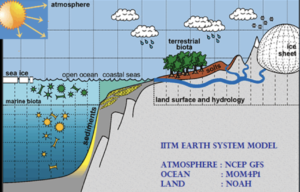Physical Address
23,24,25 & 26, 2nd Floor, Software Technology Park India, Opp: Garware Stadium,MIDC, Chikalthana, Aurangabad, Maharashtra – 431001 India
Physical Address
23,24,25 & 26, 2nd Floor, Software Technology Park India, Opp: Garware Stadium,MIDC, Chikalthana, Aurangabad, Maharashtra – 431001 India

By Aayushi Sharma
The Indian Institute of Tropical Meteorology (IITM), based in Pune, India, has undertaken a significant initiative aimed at constructing an Earth System Model (ESM) specifically tailored for the precise detection, attribution, and projection of alterations in the South Asian Monsoon. To achieve this ambitious objective, the institute has meticulously transformed a cutting-edge seasonal prediction model, known as the Climate Forecast System version 2 (CFSv2), into a comprehensive climate model conducive for conducting prolonged climate simulations. This adaptation ensures that the model’s capabilities align seamlessly with the complexities inherent in studying and forecasting the intricate dynamics of the South Asian monsoon system.
This groundbreaking initiative aims to:
(a) enhance climate forecasting capabilities and
(b) anticipate climate repercussions.
Forecasts generated by the model will offer dependable insights into global and regional climate patterns, including the crucial Indian monsoon rainfall. By assimilating diverse elements of the Earth system—ranging from the atmosphere and oceans to landmasses, ice caps, and biospheres—the model will ascertain climate variations across various scenarios. This endeavour aligns with the government’s commitment to tackling climate change head-on, reflecting a concerted effort to confront environmental challenges.
What is the newly designed Earth System Model? How does it work?
The Earth system model (ESM) represents a pioneering open-source software engineered to seamlessly incorporate the intricate dynamics among the atmosphere, ocean, land, ice, and biosphere.
Objective: Its fundamental objective is to extrapolate the prevailing conditions of regional and global climate across diverse scenarios. Harnessing the principles of numerical weather prediction and data assimilation, the ESM emerges as a potent tool for precise climate change prognostication. As elucidated by officials from the Ministry of Earth Sciences, the ESM’s robust framework enables accurate predictions by simulating the interplay among Earth’s various subsystems, thus offering invaluable insights into the changing climate landscape.
At its core, the Earth system model functions as a sophisticated simulator, adapting interdependencies between atmospheric processes, oceanic currents, terrestrial ecosystems, polar ice dynamics, and biological phenomena. By encapsulating these multifaceted interactions within its computational framework, the ESM facilitates a comprehensive understanding of the Earth’s climate system. This holistic approach allows researchers to delve into the intricate nuances of climate dynamics and predict how they might evolve under diverse scenarios, ranging from shifting greenhouse gas concentrations to alterations in land use patterns.
Benefits of the new model:
References:
https://rcc.imdpune.gov.in/clim_projection.php
Image sources:
Comments are closed.
I like the valuable info you provide in your articles.
I will bookmark your blog and check again here regularly.
I’m quite sure I’ll learn a lot of new stuff right
here! Best of luck for the next!
Ponto IPTV a melhor programacao de canais IPTV do Brasil, filmes, series, futebol
My website: порно рыжие молодые
Muchos Gracias for your article.Really thank you! Cool.
My website: порно букаки
This site definitely has all of the information I needed about this subject
My website: мжм с женой